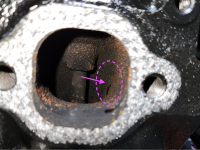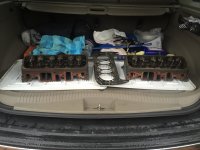Lou C
Supreme Mariner
- Joined
- Nov 10, 2002
- Messages
- 13,776
I'd say so, still I wonder where the moisture came from? Maybe only condensation? I know that Merc did a few things to try to keep the manifolds hotter to prevent condensation from forming in the exhaust.
The tried the warm manifolds set up were the manifolds don't get water flow till the 'stat opens, then when they changed to the dry joint they used a type of flange on the gasket to keep moisture out.
On my engine which uses the OMC/Volvo set up, the manifolds run cool, like at 95-100* at idle and the most they ever get it to is about 135-140*. What OMC and Volvo seemed to have done, is run a higher temp stat, 160 instead of the 140 that older Mercs used, to achieve the same goal.
so thinking back yours has the cold manifold set up, what temp 'stat are you using? if a 140 maybe try a 160 like the later Mercs used.
On and BTW, the business about a lower temp stat being needed in salt, well mine has had only a 160 and in 20 years of salt water use, when I took it apart, there were no clogged cooling passages, just an even coating of typical cast iron rust. Maybe that's true in Florida, or the Gulf coast but here in the cooler waters of the north east, I don't see it being a problem at least for a cast iron raw water cooled inboard.
At the end of this season I'll probably pull my exhaust to check it, if I do I'll post up pix.
The tried the warm manifolds set up were the manifolds don't get water flow till the 'stat opens, then when they changed to the dry joint they used a type of flange on the gasket to keep moisture out.
On my engine which uses the OMC/Volvo set up, the manifolds run cool, like at 95-100* at idle and the most they ever get it to is about 135-140*. What OMC and Volvo seemed to have done, is run a higher temp stat, 160 instead of the 140 that older Mercs used, to achieve the same goal.
so thinking back yours has the cold manifold set up, what temp 'stat are you using? if a 140 maybe try a 160 like the later Mercs used.
On and BTW, the business about a lower temp stat being needed in salt, well mine has had only a 160 and in 20 years of salt water use, when I took it apart, there were no clogged cooling passages, just an even coating of typical cast iron rust. Maybe that's true in Florida, or the Gulf coast but here in the cooler waters of the north east, I don't see it being a problem at least for a cast iron raw water cooled inboard.
At the end of this season I'll probably pull my exhaust to check it, if I do I'll post up pix.
Last edited:






















